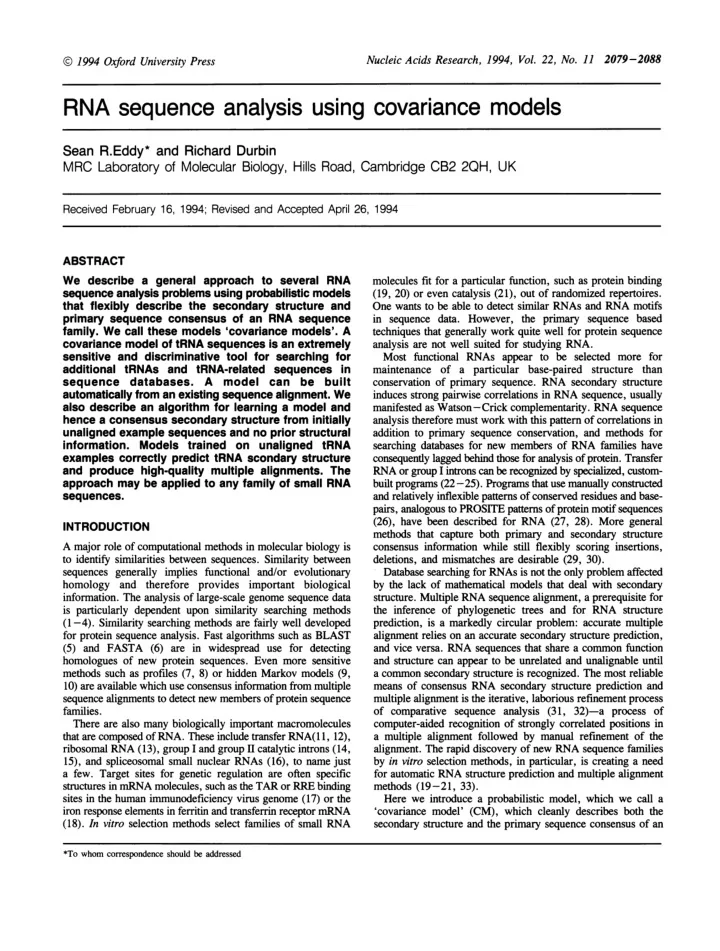

.. 1994 Oxford University Press Nucleic Acids Research, 1994, Vol. 22, No. 11 2079-2088 RNA sequence analysis using covariance models Sean R.Eddy* and Richard Durbin MRC Laboratory of Molecular Biology, Hills Road, Cambridge CB2 2QH, UK Received February 16, 1994; Revised and Accepted April 26, 1994 ABSTRACT We describe a general approach to several RNA molecules fit for a particular function, such as protein binding sequence analysis problems using probabilistic models (19, 20) or even catalysis (21), out of randomized repertoires. that flexibly describe the secondary structure and One wants to be able to detect similar RNAs and RNA motifs primary sequence consensus of an RNA sequence the primary sequence based in sequence data. However, family. We call these models 'covariance models'. A techniques that generally work quite well for protein sequence covariance model of tRNA sequences is an extremely analysis are not well suited for studying RNA. sensitive and discriminative tool for searching for Most functional RNAs appear to be selected more for additional tRNAs and tRNA-related sequences in particular base-paired than maintenance of a structure sequence databases. A model can be built conservation of primary sequence. RNA secondary structure automatically from an existing sequence alignment. We induces strong pairwise correlations in RNA sequence, usually also describe an algorithm for learning a model and manifested as Watson-Crick complementarity. RNA sequence hence a consensus secondary structure from initially analysis therefore must work with this pattern of correlations in unaligned example sequences and no prior structural addition to primary sequence conservation, and methods for information. Models trained unaligned tRNA searching databases for new members of RNA families have on examples correctly predict tRNA scondary structure consequently lagged behind those for analysis of protein. Transfer and produce high-quality multiple alignments. The RNA or group I introns can be recognized by specialized, custom- approach may be applied to any family of small RNA built programs (22-25). Programs that use manually constructed and relatively inflexible patterns of conserved residues and base- sequences. pairs, analogous to PROSITE patterns of protein motif sequences (26), have been described for RNA (27, 28). More general INTRODUCTION methods that capture both primary and secondary structure A major role of computational methods in molecular biology is consensus information while still flexibly scoring insertions, to identify similarities between sequences. Similarity between deletions, and mismatches are desirable (29, 30). sequences generally implies functional and/or evolutionary Database searching for RNAs is not the only problem affected homology and therefore provides important biological by the lack of mathematical models that deal with secondary structure. Multiple RNA sequence alignment, a prerequisite for information. The analysis of large-scale genome sequence data the inference of phylogenetic trees and for RNA structure is particularly dependent upon similarity searching methods (1-4). Sirnilarity searching methods are fairly well developed prediction, is a markedly circular problem: accurate multiple alignment relies on an accurate secondary structure prediction, for protein sequence analysis. Fast algorithms such as BLAST are in widespread use for detecting (5) and FASTA (6) and vice versa. RNA sequences that share a common function and structure can appear to be unrelated and unalignable until homologues of new protein sequences. Even more sensitive methods such as profiles (7, 8) or hidden Markov models (9, a common secondary structure is recognized. The most reliable 10) are available which use consensus information from multiple means of consensus RNA secondary structure prediction and sequence alignments to detect new members of protein sequence multiple alignment is the iterative, laborious refinement process families. of comparative sequence analysis (31, 32)-a process of computer-aided recognition of strongly correlated positions in There are also many biologically important macromolecules a multiple alignment followed by manual refinement of the that are composed of RNA. These include transfer RNA(1 1, 12), ribosomal RNA (13), group I and group II catalytic introns (14, alignment. The rapid discovery of new RNA sequence families 15), and spliceosomal small nuclear RNAs (16), to name just by in vitro selection methods, in particular, is creating a need a few. Target sites for genetic regulation are often specific for automatic RNA structure prediction and multiple alignment structures in mRNA molecules, such as the TAR or RRE binding methods (19-21, 33). sites in the human immunodeficiency virus genome (17) or the Here we introduce a probabilistic model, which we call a iron response elements in ferritin and transferrin receptor mRNA 'covariance model' (CM), which cleanly describes both the (18). In vitro selection methods select families of small RNA secondary structure and the primary sequence consensus of an *To whom correspondence should be addressed
Recommend
More recommend